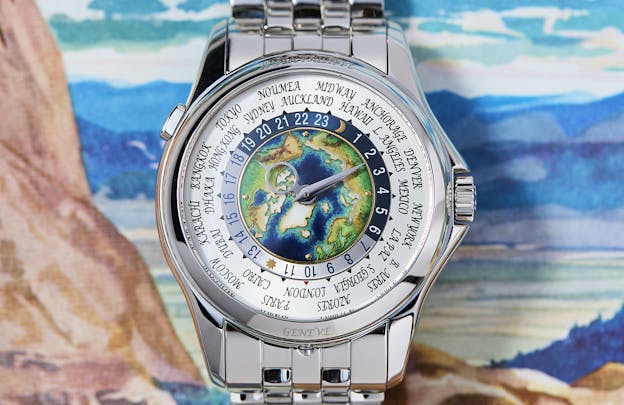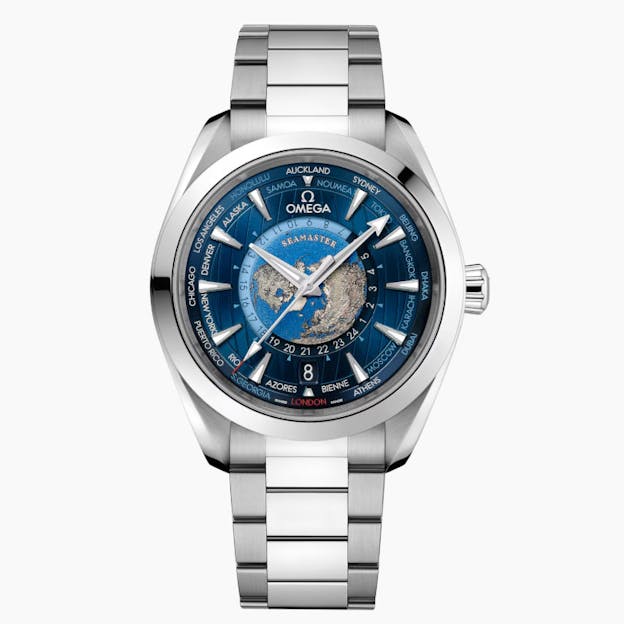Omega’s Seamaster Planet Ocean Worldtimer: A Globe-Trotter Built For The Abyss
Why stop at 150 meters? Omega’s latest worldtimer doubles down on depth and design.
When you want more of something—you want some more. I’m pretty sure that’s a quote from something buried deep in the pop culture archives of my scattered brain, but it feels fitting here. If it isn’t already obvious, Omega is giving you more of everything in their latest release.
The Seamaster Planet Ocean Worldtimer is built for globetrotting while also being capable of diving 600 meters beneath the ocean’s surface. There isn’t much—if anything—that even the most extreme explorers or adventurers could throw at this watch that it couldn’t handle. Now available in two new colorways, it remains a watch for a very specific kind of person—but that doesn’t mean we can’t appreciate the sheer audacity of Omega going all-in on this one. As I mentioned in my Bronze Gold write-up, this isn’t just another colorway.
The Omega Seamaster Planet Ocean Worldtimer

Omega has taken its worldtimer complication to new depths—literally. What started in 2017 as part of the Aqua Terra 150M line has now evolved into something far more extreme (I think that is the word to use here). With the same movement as its predecessor, the Co-Axial Master Chronometer Caliber 8938, Omega increased its water resistance from 150 meters to 600 meters— making sure this these watches stay true to the Planet Ocean line.

Borrowing the deep-diving aesthetic of the Planet Ocean Deep Black, these new worldtimers come in an all-ceramic 45.5mm case (more on this below). The brushed black ceramic [ZrO2] case and bezel give it that international spy stealth-like presence, with a laser-ablated diving scale (which if you were wondering is a fancy way of saying they used a laser to remove material).

But the real showpiece is at the center of the dial: a laser-etched topographic map of Earth, rendered on a grade 5 titanium surface, offering a view from the North Pole. Surrounding this miniature world is a 24-hour ring under hesalite glass, splitting day and night, while the outer section of the dial is finished in DLC black with a polished honeycomb texture.
I know I joke a lot but you would have to be blind to tell me this watch doesn’t look cool. This new edition comes in two variants, a turquoise model and a grey model… I for one probably prefer the turquoise, but this may change tomorrow. Check back in then and I will let you know.
The turquoise-accented model with hands and indices filled with white Super-LumiNova, paired with a black structured rubber strap featuring turquoise stitching and a ceramic and ceramized titanium foldover clasp, because titanium wasn’t cool enough.
The grey-accented model with hands and indices using Omega’s new grey Super-LumiNova, also on a black structured rubber strap, but with a grey underside.

True to its worldtimer roots, the dial’s city ring connects wearers to the 24 global time zones, with Omega’s hometown of Bienne proudly sitting at GMT+1. But unlike previous iterations, this one isn’t just built for life on the land—it’s ready to dive deeper than ever before, thanks to its 600m (2000ft) water resistance.
Technical Impact On Watch Size

I won’t dive into the history and evolution of the worldtimer, as Jack has already done that better than I ever could. That said, I do feel it is important to point out some interesting aspects of the evolution of the worldtimer to better help our understanding of probably the biggest (pun intended) elephant in the room when it comes to this new model.
The key difference between Omega’s worldtime complication and the Patek Philippe/Cottier system (the original worldtimer system) comes down to how they handle local time adjustments.
The Patek system uses a pusher to advance the hour hand in one-hour increments, simultaneously rotating the city ring so that the local time city is always positioned at 12:00. The Omega, on the other hand, has a fixed city ring, meaning you have to set the city manually using the crown. Not the biggest difference right?

Come a little closer… because that original Cottier system, and most early worldtimers didn’t include a date. I mean why would they? Have you ever traveled across twelve time zones? I promise you never know what day it is, and neither will your watch. Anyway, this wasn’t an aesthetic choice but an engineering limitation—there simply wasn’t enough space under the dial for a WT complication and a date ring unless you significantly increased the case diameter.
Enter Omega, who apparently said they wanted some more case and they got some more case, opting for a nearly 46mm (45.5mm to be exact) case size to accommodate the updated movement. They didn’t stop there, as it also measures almost 17.4mm thick. Personally, I’d be more than happy to sacrifice the date for a smaller, more wearable watch. I’d sacrifice some depth rating as well. I’de sacrifice my big toe while we are at it. At this size, it’s verging on unwearable for most people—it looks like a lifted truck on the wrist.

That all said, Omega didn’t design this watch for those looking for a dainty timepiece. And it does stay true to the Planet Ocean line, which is 49mm x 16.1mm (not the Ultra Deep). Adding the worldtime module to the movement only accounts for an extra 1.3mm in thickness, which isn’t too shabby. It is also important to keep in mind the world is not awash in 600m worldtimers, so they are definitely filling a niche here. Omega also only has one other worldtimer available in the Aqua Terra 150, so expanding on this complication’s offerings fits well for the company. And putting this in ceramic does keep the weight down so we have that going for us.
The Worldtimer Dilemma

As someone who appreciates the romanticism of a worldtimer, I have to admit that the complication is, to some degree, ostentatious. It’s not the most practical function, given how easily a politician’s pen stroke can render an expensive worldtimer inaccurate. Case in point: early worldtimers displayed Paris and London in the same time zone. During the German occupation in WWII, Paris was shifted to Central European Time (CET) and never reverted after the war. Patek Philippe, however, assumed Paris would return to London time and continued making world timers that reflected that assumption—an obscure but fascinating detail that watch nerds obsess over when hunting for historically significant pieces.

The reality is that time zones, and by extension, modern-day timing laws like daylight savings time, are arbitrary. They don’t follow any natural phenomenon. Take China, for example—the entire country operates on GMT+8, despite its vast geographic spread. Meanwhile, Chile, which is as narrow as a toothpick in comparison, has three time zones. Most of continental Chile follows UTC−04:00 in winter and UTC−03:00 in summer, while the Magallanes and Chilean Antarctica region remain on UTC−03:00 year-round.
And if you really want your OCD to kick in, look no further than Eucla, Australia, which runs on GMT+8:45—yes, fractionalized time zones exist. Try tracking that on your worldtimer. The more you know, right?
The 1916 Company is an authorized retailer of Omega watches. Explore locations and boutiques.
Available in two variations—turquoise (Ref. 215.92.46.22.01.006) and gray (Ref. 215.92.46.22.01.007)—the watch features a black ceramic (ZrO2) case with a brushed finish. Measuring 45.5mm in diameter, 51.4mm lug-to-lug, and 17.4 mm thick, it commands a strong presence on the wrist. At its core, a titanium dial center showcases a world map, luminous applied indexes, a date window, and a 24-city world time scale. Under the domed sapphire crystal with anti-reflective coating, the Omega Co-Axial Master Chronometer Caliber 8938 powers the watch with a 60-hour reserve, METAS-certified accuracy, and resistance to magnetic fields up to 15,000 gauss and 600 meter water resistance.
It comes fitted on a curved-end black rubber strap with sailcloth texture, accented in either turquoise or gray, and secured with a ceramic and titanium folding clasp. Priced at $16,800. For more information visit Omegawatches.com.

